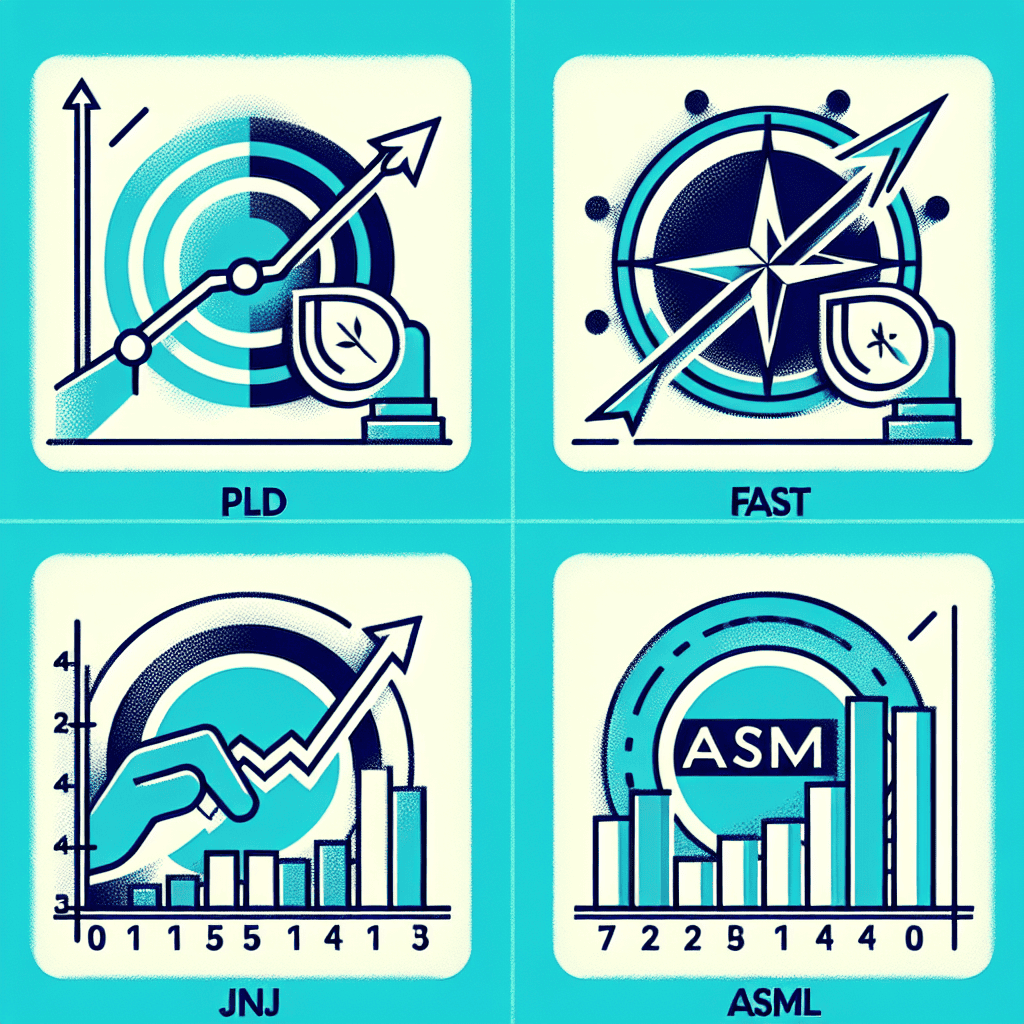“Unlocking Growth: Strategic Insights into PLD, FAST, JNJ, and ASML”
Introduction
Market Insights: PLD, FAST, JNJ, ASML Analysis provides a comprehensive examination of four significant players in diverse sectors: Prologis, Inc. (PLD), Fastenal Company (FAST), Johnson & Johnson (JNJ), and ASML Holding N.V. (ASML). This analysis delves into the financial performance, market trends, and strategic positioning of each company, offering a detailed overview of their roles within the real estate, industrial supply, healthcare, and semiconductor industries, respectively. By evaluating key metrics, competitive advantages, and potential growth opportunities, this report aims to equip investors and stakeholders with the necessary insights to make informed decisions in an ever-evolving market landscape.
Understanding PLD’s Market Position and Growth Potential
In the ever-evolving landscape of global markets, understanding the position and growth potential of key players is crucial for investors and analysts alike. Prologis, Inc. (PLD), a leading global logistics real estate investment trust (REIT), stands out as a significant entity in this domain. As the demand for logistics and warehousing solutions continues to surge, driven by the exponential growth of e-commerce and the need for efficient supply chain management, Prologis is strategically positioned to capitalize on these trends.
Prologis has established itself as a dominant force in the logistics real estate sector, with a vast portfolio of properties strategically located near major urban centers and transportation hubs. This strategic positioning not only enhances the company’s ability to attract and retain high-quality tenants but also ensures a steady stream of rental income. Furthermore, Prologis’s focus on sustainability and innovation, such as the integration of smart building technologies and renewable energy solutions, aligns with the growing emphasis on environmental responsibility, thereby enhancing its appeal to environmentally conscious investors and tenants.
Transitioning to the financial performance of Prologis, the company has consistently demonstrated robust growth metrics. Its revenue streams have been bolstered by a combination of organic growth and strategic acquisitions, allowing it to expand its footprint and diversify its asset base. Moreover, Prologis’s strong balance sheet and prudent capital management practices have enabled it to maintain a healthy financial position, providing the flexibility to pursue growth opportunities and weather economic uncertainties.
In addition to its solid financial foundation, Prologis benefits from favorable market dynamics. The ongoing shift towards e-commerce has created an insatiable demand for logistics facilities, as retailers and manufacturers seek to optimize their distribution networks. This trend is expected to persist, driven by the increasing consumer preference for online shopping and the need for rapid delivery services. Consequently, Prologis is well-positioned to capture a significant share of this growing market, leveraging its extensive network of properties and expertise in logistics real estate.
Furthermore, Prologis’s commitment to innovation and technology adoption sets it apart from its competitors. By embracing cutting-edge solutions such as automation, data analytics, and the Internet of Things (IoT), the company enhances operational efficiency and tenant satisfaction. These technological advancements not only streamline logistics operations but also provide valuable insights into tenant needs and market trends, enabling Prologis to make informed decisions and maintain a competitive edge.
While Prologis’s market position and growth potential are undeniably strong, it is essential to consider potential challenges that may impact its trajectory. Economic fluctuations, changes in interest rates, and geopolitical uncertainties could influence the demand for logistics real estate. However, Prologis’s diversified portfolio and global presence mitigate these risks to a certain extent, providing a buffer against regional economic downturns.
In conclusion, Prologis’s strategic positioning, robust financial performance, and commitment to innovation underscore its strong market position and growth potential. As the logistics real estate sector continues to evolve, driven by the rise of e-commerce and technological advancements, Prologis is well-equipped to navigate the challenges and capitalize on the opportunities that lie ahead. For investors seeking exposure to the logistics real estate market, Prologis represents a compelling option, offering a blend of stability, growth, and innovation.
Analyzing FAST’s Competitive Edge in the Industrial Sector
In the ever-evolving landscape of the industrial sector, Fastenal Company (FAST) has consistently demonstrated a robust competitive edge, distinguishing itself from its peers through strategic initiatives and operational excellence. As we delve into the factors contributing to Fastenal’s market position, it becomes evident that a combination of innovative supply chain solutions, customer-centric approaches, and technological advancements have played pivotal roles in shaping its success.
To begin with, Fastenal’s supply chain management is a cornerstone of its competitive advantage. The company has developed an extensive distribution network that ensures timely delivery of products to its customers. This network is supported by a sophisticated inventory management system that optimizes stock levels and reduces lead times. By maintaining a vast array of products readily available, Fastenal can meet the diverse needs of its clientele, ranging from small businesses to large industrial enterprises. This capability not only enhances customer satisfaction but also fosters long-term loyalty, as clients can rely on Fastenal for consistent and reliable service.
Moreover, Fastenal’s customer-centric approach is another critical factor that sets it apart in the industrial sector. The company places a strong emphasis on understanding the unique requirements of its customers and tailoring solutions to meet those needs. This is achieved through a combination of personalized service and a deep understanding of the industries it serves. Fastenal’s sales team is trained to provide expert advice and support, ensuring that customers receive the most suitable products and services for their specific applications. This level of engagement not only strengthens customer relationships but also positions Fastenal as a trusted partner in their operational success.
In addition to its supply chain and customer service strengths, Fastenal has embraced technological advancements to further solidify its competitive edge. The company has invested in digital platforms and e-commerce solutions, enabling customers to access its vast product catalog with ease. This digital transformation has streamlined the purchasing process, making it more convenient for customers to place orders and track deliveries. Furthermore, Fastenal’s use of data analytics allows it to gain insights into customer behavior and preferences, enabling the company to anticipate market trends and adjust its offerings accordingly. By leveraging technology, Fastenal not only enhances its operational efficiency but also stays ahead of the competition in an increasingly digital world.
Transitioning to the broader market context, it is important to note that Fastenal operates in a highly competitive environment, with numerous players vying for market share. However, the company’s strategic focus on supply chain excellence, customer-centricity, and technological innovation has enabled it to maintain a strong position in the industry. While competitors may attempt to replicate Fastenal’s strategies, the company’s established infrastructure and deep-rooted customer relationships provide a formidable barrier to entry.
In conclusion, Fastenal’s competitive edge in the industrial sector is the result of a well-rounded approach that combines efficient supply chain management, a customer-first mindset, and a commitment to technological advancement. As the industrial landscape continues to evolve, Fastenal’s ability to adapt and innovate will be crucial in sustaining its market leadership. By remaining attuned to the needs of its customers and leveraging its strengths, Fastenal is well-positioned to navigate the challenges and opportunities that lie ahead, ensuring its continued success in the years to come.
JNJ’s Strategic Moves in the Healthcare Market
In the ever-evolving landscape of the healthcare market, Johnson & Johnson (JNJ) continues to assert its dominance through strategic maneuvers that underscore its commitment to innovation and growth. As a stalwart in the industry, JNJ’s approach is multifaceted, encompassing acquisitions, research and development, and a keen focus on emerging markets. These strategies not only bolster its current market position but also pave the way for sustained future success.
To begin with, JNJ’s acquisition strategy is a cornerstone of its growth model. By identifying and integrating companies that complement its existing portfolio, JNJ enhances its capabilities and expands its reach. A notable example is the acquisition of Auris Health, a pioneer in robotic technologies. This move not only strengthens JNJ’s position in the surgical robotics space but also aligns with its broader vision of advancing minimally invasive procedures. Such acquisitions are not merely about expanding product lines; they are strategic investments in technologies that promise to redefine healthcare delivery.
In addition to acquisitions, JNJ places a significant emphasis on research and development (R&D). The company consistently allocates substantial resources to R&D, recognizing that innovation is the lifeblood of the healthcare industry. By investing in cutting-edge research, JNJ aims to address unmet medical needs and bring novel therapies to market. This commitment is evident in its robust pipeline, which spans a diverse range of therapeutic areas, including oncology, immunology, and neuroscience. The focus on R&D not only drives product innovation but also enhances JNJ’s competitive edge in a crowded marketplace.
Moreover, JNJ’s strategic focus extends to emerging markets, which present significant growth opportunities. As healthcare infrastructure improves and demand for quality medical care rises in these regions, JNJ is well-positioned to capitalize on these trends. The company’s strategy involves tailoring its offerings to meet the specific needs of these markets, ensuring accessibility and affordability. By doing so, JNJ not only taps into new revenue streams but also fulfills its mission of improving global health outcomes.
Furthermore, JNJ’s strategic moves are underpinned by a commitment to sustainability and corporate responsibility. The company recognizes that long-term success is inextricably linked to sustainable practices. As such, JNJ has set ambitious goals to reduce its environmental footprint and enhance the sustainability of its operations. This commitment resonates with stakeholders and reinforces JNJ’s reputation as a responsible corporate citizen.
In conclusion, Johnson & Johnson’s strategic moves in the healthcare market are a testament to its forward-thinking approach and unwavering commitment to innovation. Through targeted acquisitions, robust R&D investments, and a focus on emerging markets, JNJ not only strengthens its current market position but also lays the groundwork for future growth. Coupled with its dedication to sustainability, these strategies ensure that JNJ remains at the forefront of the healthcare industry, poised to meet the challenges and opportunities of tomorrow. As the healthcare landscape continues to evolve, JNJ’s strategic vision and execution will undoubtedly play a pivotal role in shaping the future of healthcare.
ASML’s Role in the Semiconductor Industry

ASML Holding N.V. plays a pivotal role in the semiconductor industry, serving as a cornerstone for technological advancement and innovation. As the world’s leading provider of photolithography equipment, ASML’s influence extends across the entire semiconductor manufacturing process. The company’s cutting-edge technology is indispensable for producing the intricate and densely packed microchips that power modern electronic devices. This article delves into ASML’s significant contributions to the semiconductor industry, highlighting its technological advancements, market position, and future prospects.
To begin with, ASML’s dominance in the semiconductor industry is largely attributed to its development of extreme ultraviolet (EUV) lithography machines. These machines are essential for producing the next generation of microchips, which are smaller, faster, and more efficient. EUV technology allows for the creation of circuits with incredibly fine details, enabling chip manufacturers to continue following Moore’s Law, which predicts the doubling of transistors on a microchip approximately every two years. This technological leap is crucial as it supports the ongoing demand for more powerful and energy-efficient electronic devices, from smartphones to data centers.
Moreover, ASML’s strategic partnerships with major semiconductor manufacturers such as Intel, Samsung, and TSMC underscore its integral role in the industry. These collaborations not only ensure a steady demand for ASML’s products but also foster innovation through shared research and development efforts. By working closely with these industry giants, ASML is able to tailor its technology to meet the specific needs of its clients, thereby reinforcing its market leadership.
In addition to its technological prowess, ASML’s financial performance further cements its position as a key player in the semiconductor sector. The company has consistently reported robust revenue growth, driven by the increasing adoption of EUV technology and the expansion of the global semiconductor market. This financial strength enables ASML to invest heavily in research and development, ensuring that it remains at the forefront of technological innovation. Furthermore, ASML’s strong balance sheet provides it with the flexibility to explore new opportunities and expand its product offerings, thereby enhancing its competitive edge.
Looking ahead, ASML is well-positioned to capitalize on several emerging trends within the semiconductor industry. The growing demand for artificial intelligence, 5G technology, and the Internet of Things (IoT) is expected to drive further advancements in semiconductor technology, creating new opportunities for ASML. As these technologies become more prevalent, the need for advanced microchips will continue to rise, bolstering the demand for ASML’s state-of-the-art lithography machines.
In conclusion, ASML’s role in the semiconductor industry is both influential and indispensable. Through its pioneering EUV technology, strategic partnerships, and strong financial performance, ASML has established itself as a leader in the field. As the industry continues to evolve, ASML’s commitment to innovation and excellence will undoubtedly play a crucial role in shaping the future of semiconductor manufacturing. By maintaining its focus on cutting-edge technology and strategic collaboration, ASML is poised to remain at the forefront of the semiconductor industry, driving progress and enabling the next wave of technological advancements.
Comparative Analysis of PLD and FAST: Market Trends and Forecasts
In the ever-evolving landscape of the stock market, understanding the nuances of individual companies and their market trends is crucial for investors seeking to make informed decisions. This analysis delves into the comparative market trends and forecasts of Prologis, Inc. (PLD) and Fastenal Company (FAST), two prominent players in their respective industries. By examining their recent performances, market positions, and future prospects, we aim to provide a comprehensive overview that aids in discerning potential investment opportunities.
Prologis, Inc., a leading global logistics real estate company, has consistently demonstrated robust growth, driven by the increasing demand for logistics and warehousing solutions. The rise of e-commerce and the subsequent need for efficient supply chain management have positioned PLD favorably within the market. Over the past few years, Prologis has capitalized on these trends by expanding its portfolio and enhancing its technological capabilities. This strategic positioning has not only bolstered its market share but also solidified its reputation as a key player in the logistics real estate sector. Furthermore, Prologis’s commitment to sustainability and innovation has resonated well with environmentally conscious investors, further enhancing its appeal.
In contrast, Fastenal Company, a major distributor of industrial and construction supplies, has navigated a different set of market dynamics. The company has benefited from the resurgence of manufacturing activities and infrastructure development, which have spurred demand for its products. Fastenal’s extensive distribution network and focus on customer service have been instrumental in maintaining its competitive edge. Additionally, the company’s strategic investments in technology and automation have streamlined operations, resulting in improved efficiency and cost-effectiveness. These factors have contributed to Fastenal’s steady financial performance and its ability to adapt to changing market conditions.
While both PLD and FAST have shown resilience and adaptability, their future trajectories are shaped by distinct market forces. For Prologis, the continued growth of e-commerce and the increasing emphasis on supply chain resilience are expected to drive demand for logistics real estate. The company’s strategic acquisitions and development projects are likely to further enhance its market position. However, potential challenges such as rising interest rates and geopolitical uncertainties could impact its growth prospects. Investors should closely monitor these factors to assess their potential impact on Prologis’s performance.
On the other hand, Fastenal’s future growth is closely tied to the broader economic environment and industrial activity. The company’s ability to capitalize on infrastructure spending and manufacturing growth will be pivotal in sustaining its momentum. Moreover, Fastenal’s focus on expanding its product offerings and enhancing its digital capabilities positions it well to capture emerging opportunities. Nevertheless, potential risks such as supply chain disruptions and fluctuations in raw material prices could pose challenges to its growth trajectory.
In conclusion, both Prologis and Fastenal present compelling investment opportunities, albeit influenced by different market dynamics. Prologis’s strength lies in its strategic positioning within the logistics real estate sector, while Fastenal’s resilience is rooted in its robust distribution network and adaptability to industrial trends. As investors evaluate these companies, it is essential to consider the broader economic landscape and industry-specific factors that could influence their future performance. By doing so, investors can make informed decisions that align with their investment objectives and risk tolerance.
JNJ’s Innovations and Their Impact on Market Dynamics
Johnson & Johnson (JNJ), a stalwart in the healthcare sector, has long been recognized for its commitment to innovation and its ability to adapt to the ever-evolving market dynamics. As a company that operates at the intersection of pharmaceuticals, medical devices, and consumer health products, JNJ’s innovations have consistently played a pivotal role in shaping market trends and influencing competitive landscapes. In recent years, the company’s strategic focus on research and development has not only bolstered its product portfolio but also reinforced its position as a leader in the healthcare industry.
One of the key areas where JNJ has demonstrated significant innovation is in its pharmaceutical division. The company has invested heavily in developing novel therapies that address unmet medical needs, particularly in the fields of oncology, immunology, and neuroscience. For instance, JNJ’s advancements in cancer treatment have been noteworthy, with the introduction of targeted therapies that offer improved efficacy and reduced side effects compared to traditional chemotherapy. These innovations have not only enhanced patient outcomes but have also driven substantial revenue growth for the company, thereby impacting market dynamics by setting new standards for treatment protocols.
Moreover, JNJ’s commitment to innovation extends beyond pharmaceuticals to its medical devices segment. The company has been at the forefront of developing cutting-edge technologies that improve surgical outcomes and patient care. Innovations such as minimally invasive surgical instruments and advanced diagnostic tools have revolutionized the way healthcare is delivered, offering both clinicians and patients more efficient and effective solutions. This focus on technological advancement has allowed JNJ to maintain a competitive edge in the medical devices market, influencing industry trends and encouraging other companies to invest in similar innovations.
In addition to its product innovations, JNJ has also embraced digital transformation as a means to enhance its operations and customer engagement. The integration of digital technologies into its business model has enabled the company to streamline its supply chain, optimize manufacturing processes, and improve data analytics capabilities. By leveraging digital tools, JNJ has been able to respond more swiftly to market demands and anticipate future trends, thereby reinforcing its market position and driving growth.
Furthermore, JNJ’s innovations have had a broader impact on market dynamics by fostering collaborations and partnerships within the healthcare ecosystem. The company has actively engaged in strategic alliances with academic institutions, research organizations, and other industry players to accelerate the development of new therapies and technologies. These collaborations have not only expanded JNJ’s research capabilities but have also facilitated the sharing of knowledge and resources, ultimately benefiting the entire healthcare sector.
In conclusion, Johnson & Johnson’s unwavering commitment to innovation has been instrumental in shaping market dynamics within the healthcare industry. Through its advancements in pharmaceuticals, medical devices, and digital transformation, the company has consistently set new benchmarks for quality and efficacy. As JNJ continues to invest in research and development, its innovations are likely to have a lasting impact on the market, driving competition and encouraging further advancements in healthcare. Consequently, JNJ’s role as a leader in innovation not only enhances its own market position but also contributes to the overall progress of the industry, ultimately benefiting patients and healthcare providers worldwide.
ASML’s Technological Advancements and Market Leadership
ASML Holding N.V., a pivotal player in the semiconductor industry, has consistently demonstrated its technological prowess and market leadership. As the sole supplier of extreme ultraviolet (EUV) lithography machines, ASML has carved out a unique niche, enabling the production of advanced microchips that power a myriad of modern technologies. This exclusivity not only underscores ASML’s technological advancements but also solidifies its position as an indispensable partner to leading semiconductor manufacturers worldwide.
The company’s commitment to innovation is evident in its continuous investment in research and development. By allocating a significant portion of its revenue to R&D, ASML ensures that it remains at the forefront of technological breakthroughs. This strategic focus has allowed the company to develop cutting-edge lithography systems that are crucial for the production of smaller, faster, and more efficient chips. As the demand for high-performance computing and artificial intelligence applications grows, ASML’s advanced lithography solutions become increasingly vital.
Moreover, ASML’s technological advancements are not limited to EUV lithography. The company is also making strides in deep ultraviolet (DUV) lithography, which remains essential for many semiconductor manufacturing processes. By enhancing the capabilities of its DUV systems, ASML provides its clients with a comprehensive suite of solutions that cater to a wide range of technological needs. This versatility further strengthens ASML’s market position, as it can address the diverse requirements of its customer base.
In addition to its technological innovations, ASML’s market leadership is bolstered by its strategic partnerships with key players in the semiconductor industry. Collaborations with companies such as Intel, Samsung, and TSMC not only facilitate the development of next-generation technologies but also ensure a steady demand for ASML’s products. These partnerships are mutually beneficial, as they enable ASML to refine its offerings while providing its partners with the tools necessary to maintain their competitive edge.
Furthermore, ASML’s robust supply chain management and customer support systems play a crucial role in maintaining its market leadership. By ensuring timely delivery and installation of its complex lithography machines, ASML minimizes disruptions in its clients’ production processes. Additionally, the company’s comprehensive training and support services empower its customers to maximize the potential of their ASML equipment, thereby enhancing overall productivity and efficiency.
The global semiconductor market is poised for significant growth, driven by the increasing adoption of technologies such as 5G, the Internet of Things (IoT), and autonomous vehicles. In this context, ASML’s technological advancements and market leadership position it well to capitalize on emerging opportunities. As semiconductor manufacturers strive to meet the demands of these burgeoning markets, ASML’s state-of-the-art lithography solutions will be instrumental in enabling the production of the sophisticated chips required.
In conclusion, ASML’s technological advancements and market leadership are the result of a strategic focus on innovation, strong industry partnerships, and exceptional customer support. As the semiconductor industry continues to evolve, ASML’s unique capabilities and comprehensive solutions will ensure its continued prominence. By maintaining its commitment to excellence, ASML is well-positioned to drive the future of semiconductor manufacturing and contribute to the advancement of technology on a global scale.
Q&A
1. **PLD (Prologis) Market Insight:**
– **Q:** What is Prologis’ primary business focus?
– **A:** Prologis is a leading global logistics real estate company, focusing on owning, operating, and developing industrial properties.
2. **FAST (Fastenal) Market Insight:**
– **Q:** How does Fastenal primarily generate revenue?
– **A:** Fastenal generates revenue through the sale of industrial and construction supplies, including fasteners, tools, and safety products.
3. **JNJ (Johnson & Johnson) Market Insight:**
– **Q:** What are the main segments of Johnson & Johnson’s business?
– **A:** Johnson & Johnson operates in three main segments: Consumer Health, Pharmaceutical, and Medical Devices.
4. **ASML (ASML Holding) Market Insight:**
– **Q:** What is ASML’s role in the semiconductor industry?
– **A:** ASML is a key supplier of photolithography equipment used in the manufacturing of semiconductors, particularly known for its advanced EUV lithography machines.
5. **PLD (Prologis) Financial Performance:**
– **Q:** What financial metric is crucial for evaluating Prologis’ performance?
– **A:** Funds from Operations (FFO) is a crucial metric for evaluating Prologis’ financial performance, as it reflects the cash generated by its real estate operations.
6. **FAST (Fastenal) Competitive Advantage:**
– **Q:** What is a significant competitive advantage for Fastenal?
– **A:** Fastenal’s extensive distribution network and local branch presence provide a significant competitive advantage, enabling quick delivery and strong customer relationships.
7. **JNJ (Johnson & Johnson) Recent Development:**
– **Q:** What recent strategic move has Johnson & Johnson made?
– **A:** Johnson & Johnson has recently focused on spinning off its Consumer Health segment into a separate company, aiming to streamline operations and focus on its Pharmaceutical and Medical Devices segments.
Conclusion
The analysis of the market insights for PLD (Prologis), FAST (Fastenal), JNJ (Johnson & Johnson), and ASML (ASML Holding) reveals distinct trends and opportunities within their respective sectors. Prologis, a leader in logistics real estate, benefits from the ongoing growth in e-commerce and supply chain optimization, positioning it well for future expansion. Fastenal, a key player in industrial and construction supplies, shows resilience through its robust distribution network and focus on customer service, although it faces challenges from fluctuating industrial demand. Johnson & Johnson, a diversified healthcare giant, continues to leverage its strong pharmaceutical pipeline and consumer health products, maintaining stability despite regulatory and competitive pressures. ASML, a critical supplier in the semiconductor industry, is poised for growth driven by the increasing demand for advanced lithography equipment, essential for next-generation chip manufacturing. Overall, these companies exhibit strong market positions with varying degrees of risk and opportunity, influenced by sector-specific dynamics and broader economic conditions.





